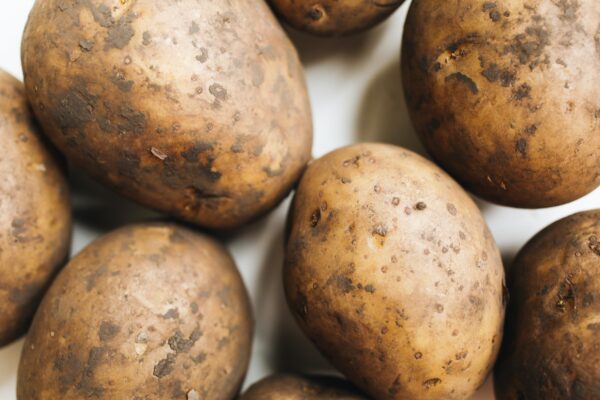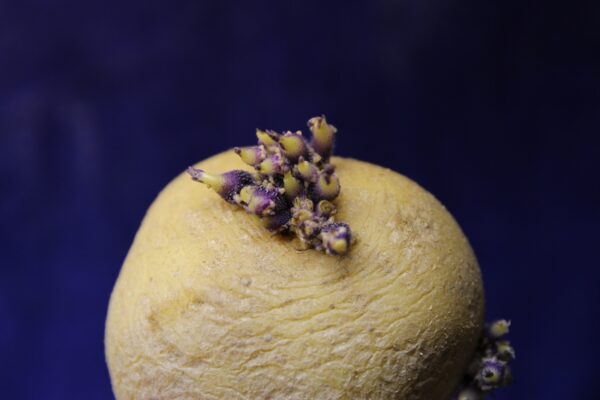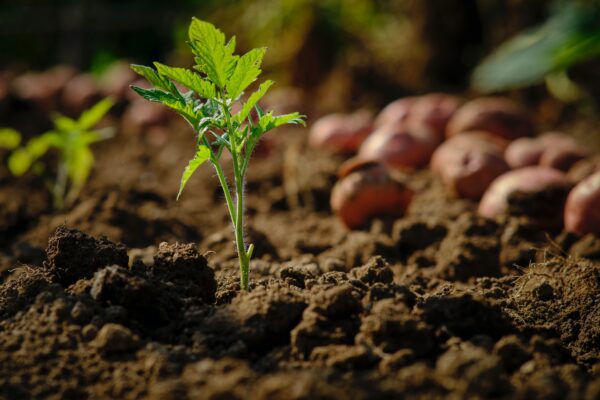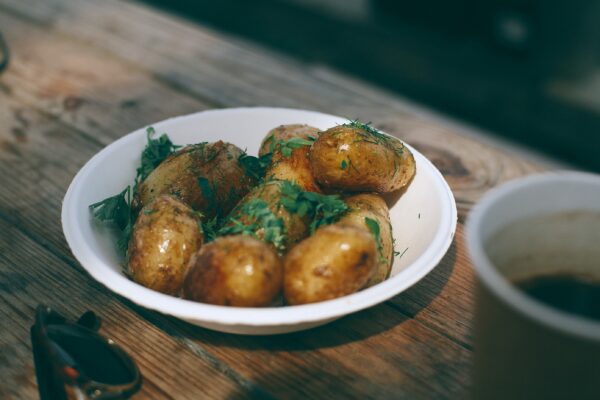Despite today’s trend of linking the potato to junk food (think French Fries or chips!) the first vegetable that I am planting early spring in my garden are potatoes! In fact, potatoes are not only a beloved comfort food, they are also considered to be healthy and help with weight loss.
Originally from South America, potatoes are the world’s fourth-largest food crop after corn, wheat and rice, and are grown and eaten all over the world. What we consume are the starchy tubers that the potato plant grows underground. As a child, I watched my grand parents growing them in large crops that would be then divided between family members and kept in root cellars to ensure our winter subsistence. In fact, before modern day globalization, many countries relied heavily on potato consumption during wintertime, and years of unsuccessful crops could have tragic consequences on their populations. The Great Famine or Irish Potato Famine, caused by potatoes blight infection combined with a mid-19th century political issues that resulted in about 1 million deaths, and an exodus of more than 2 million people from Ireland.
Nowadays, modern technologies and pesticide treatments ensure that potatoes are one of the most common vegetable available to us in any grocery store. If you are looking for your own-grown, pesticide-free alternative you can certainly give it a try.
Growing your own potatoes
But how difficult would it be to grow potatoes in your garden? Easier than one may think, as potato is a no-fuss plant that does not require a lot of attention and efforts and can yield generous crops. You can find the seed potatoes (which are not seeds but sprouting potato tubers that you can plant) at any of your local gardening hub. A good quality potato seed has to be relatively firm to touch without foul smell, and has sprouts about 1-2 inches long; however, there is no problem if sprouts are longer than that.

A few rules for best results
Potatoes love rich, loose, soil that drains well, and they need about one inch of water (or rain) every week. It is recommended to grow them in full sun; however, because our summers on the east coast are torrid and humid, I prefer to plant them on a part shade area of my garden since, originally potato is a cool climate plant from mountain regions of South America.
Despite various container growing ways available over the internet, I prefer to plant them directly in my garden soil, just the way my grandparents used to. It is a simple and cost-effective way to obtain a good crop of about 10 new potatoes per each planted tuber or tuber segment. Prior to planting, you have to dig a hole or a trench 2-3 inch deep and about 12 inches wide. At 12-inch intervals you can plant a whole potato seed that has a small size of 1-2 inches diameter.

Bigger potato seeds produce the best crop if they are cut into segments bearing 2-3 sprouts on them that will be planted separately keeping the approximate distance of 12 inches between them or won’t mature. It is recommended to have the segment air dry first, then planting them with the cut face down. Each tuber/segment needs to be covered with a few inches of soil, and if freezing is still possible, protected with a layer of straw. Application of fish bone fertilizer is also recommended to ensure vigorous plants. Just follow package instructions.
Because potatoes possess a shallow root system, they have low phosphorus uptake efficiency, and thus, they have a high requirement for soil available phosphorus (P). Thus, the addition of fish bone fertilizer, rich in P is recommended for poor soils.
Harvest time, when are they ready!
How can you tell when to harvest your potatoes? The simplest way is to watch when the plants are flowering, two weeks after flowering when the leaves start dying back, you can start harvesting and enjoy cooking your new potatoes!

Now, let’s have a look at what these delicious tubers contain. Potatoes chemical composition depends of many factors, including the cultivar variety (there are a few thousand varieties worldwide!), soil characteristics, climate, fertilizer use. Potatoes chemical composition is defined by moisture, dry matter, protein, lipid, sugar, fiber, starch and phosphorus content. Better quality potatoes have a high content of dry matter, higher percentage of starch and protein, and lower sugar content. The most important factor determining nutritious and taste qualities is the dry matter content. A higher dry matter content means lower moisture, and results in increased crispiness, less oil absorption and better tasting cooked potatoes.
Cooked potatoes are a good source of vitamins and minerals. A 2/3 coups of boiled potatoes yields approximately 87 calories with a 77% water content, 1.9 g protein, 20.1 g carbs (mainly starch), 0.9 g sugar 1.8 g fiber and 0.1 g fat. Potatoes have usually a high glycemic index (GI) unsuitable for people with diabetes. A way of lowering the GI is by cooling them after cooking which can lower the GI by 25-26%; cooling would also provide more resistant starch which feeds the friendly bacteria in gut. Potatoes are also a good source of vitamins and minerals, particularly potassium and vitamin C, concentrated in potato skin. Potato skin also contains healthy bioactive compounds, such as antioxidant polyphenols and lutein beneficial for eye health. Another aspect to consider when consuming potatoes, is that they also contain glycoalkaloids, a class of toxic phytonutrients with role in protection against pests, which can have harmful health effects if consumed in high amounts.

Several health benefits linked to potatoes consumption are important to mention. One notable benefit is helping with weight loss. Potatoes are particularly filling and induce a prolonged feeling of fulness after meals. A study of 40 common foods has shown that potatoes were the most filling. Also, a side of boiled potatoes has a lower caloric intake as compared to pasta or white rice. Thus, potatoes may be beneficial in a weight loss diet. Another health benefit is related to the minerals, vitamins and antioxidants contained in the potato skin that may lower blood pressure and heart disease, while their “resistant starch” may also improve digestive health. Potato consumption is also important to those with celiac disease and have to follow a gluten-free diet. Unlike grains such as spelt, wheat, barley and rye, potatoes do not contain the protein gluten, causing adverse reactions in people with gluten sensitivity.
Andean legends consider potatoes a gift from gods rewarding strength of character, such as the story of a young man named Choque who refused to accept the conditions that his own Sapallas people were enduring under their belligerent neighbors, the Karis. The gods, impressed by Choque’s faith and courage, offered the Sapallas the sacred seeds of potatoes. Not knowing what this new plant was, their greedy Karis oppressor’s consumed the upper poisonous parts of the plants and fell sick. The Sapallas ate the tubers that grew underground, which gave them new strength to fight the Karis, and regain independence. Since then, potatoes have been cultivated with respect as a sacred gift from gods.
It is also important to note that some people may develop potato allergy, which is mainly linked to a protein that potatoes contain, named patatin. Another class of compounds are acrylamides that form when potatoes are cooked at very high temperatures, and that may have harmful health effects. Thus, the manner of cooking potatoes is very important when considering their health benefits and weight management.
If you decide that potatoes are for you, give them a try and see if you can grow your own rewarding crop of this humble but mighty vegetable!
 RSS Feed
RSS Feed















 March 30th, 2021
March 30th, 2021  Awake Goy
Awake Goy  Posted in
Posted in  Tags:
Tags: 













